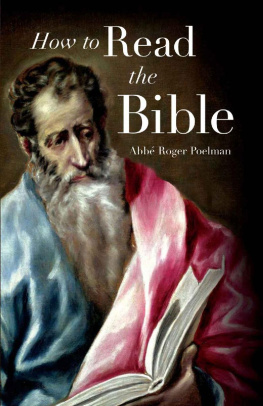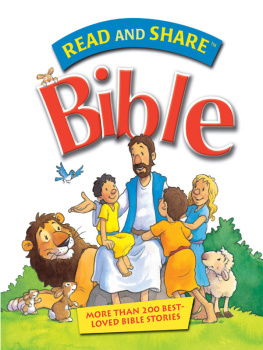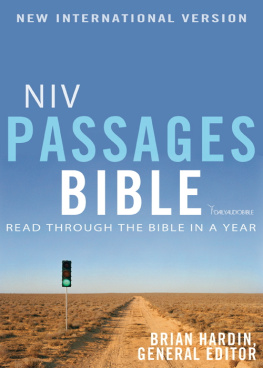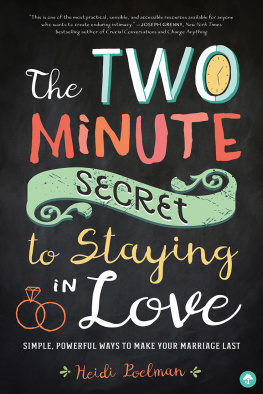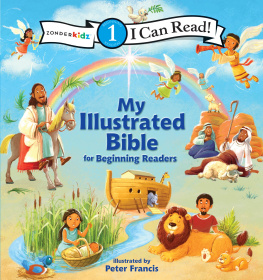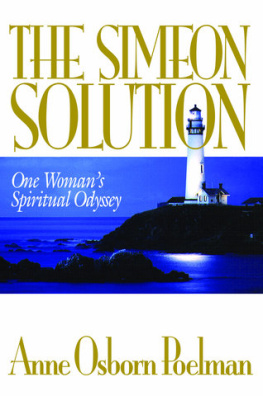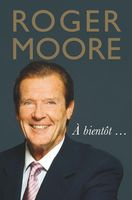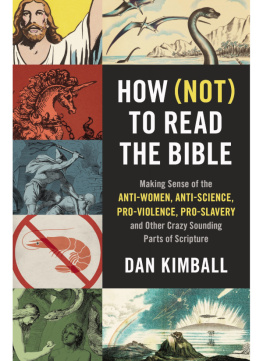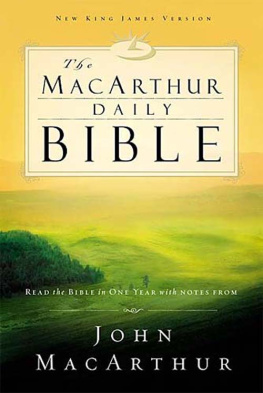Roger Poelman - How to Read the Bible
Here you can read online Roger Poelman - How to Read the Bible full text of the book (entire story) in english for free. Download pdf and epub, get meaning, cover and reviews about this ebook. year: 2013, publisher: Sophia Institute Press, genre: Religion. Description of the work, (preface) as well as reviews are available. Best literature library LitArk.com created for fans of good reading and offers a wide selection of genres:
Romance novel
Science fiction
Adventure
Detective
Science
History
Home and family
Prose
Art
Politics
Computer
Non-fiction
Religion
Business
Children
Humor
Choose a favorite category and find really read worthwhile books. Enjoy immersion in the world of imagination, feel the emotions of the characters or learn something new for yourself, make an fascinating discovery.
- Book:How to Read the Bible
- Author:
- Publisher:Sophia Institute Press
- Genre:
- Year:2013
- Rating:5 / 5
- Favourites:Add to favourites
- Your mark:
- 100
- 1
- 2
- 3
- 4
- 5
How to Read the Bible: summary, description and annotation
We offer to read an annotation, description, summary or preface (depends on what the author of the book "How to Read the Bible" wrote himself). If you haven't found the necessary information about the book — write in the comments, we will try to find it.
How to Read the Bible — read online for free the complete book (whole text) full work
Below is the text of the book, divided by pages. System saving the place of the last page read, allows you to conveniently read the book "How to Read the Bible" online for free, without having to search again every time where you left off. Put a bookmark, and you can go to the page where you finished reading at any time.
Font size:
Interval:
Bookmark:
How to Read the Bible
Abbe Roger Poelman
Translated by a Nun of Regina Laudis, O.S.B.
SOPHIA INSTITUTE PRESS
Manchester, New Hampshire
Sophia Institute Press
Box 5284, Manchester, NH 03108
1-800-888-9344
www.SophiaInstitute.com
Cover design by Theodore Schluenderfritz.
Image: St. Matthew by El Greco, Indianapolis Museum of Art, USA/ The Clowes Fund Collection/ The Bridgeman Art Library.
Printed in the United States of America.
This translation is made from the second edition of Ouvrons la Bibley published in 1953 by P.J. Kenedy & Sons, New York.
Nihil Obstat:
Rev. Leonard A. Bushinski, C.S.Sp.
Censor Deputatis
Imprimatur:
Most Reverend Henry J. OBrien, D.D.
Bishop of Hartford,
February 23, 1953
[Ouvrons la Bible. English]
How to read the Bible / Roger Poelman ; translated by a Nun of Regina Laudis.
p. cm.Originially published: New York : P. J. Kenedy & Sons, 1953.
Includes bibliographical references and index.
ISBN 978-1-933184-66-1 (ppbk : alk. paper) 1. BibleReading. 2. BibleOutlines, syllabi, etc. I. Title.BS617.P614 2010
220.07dc222009037193
Editor's Note
This is a fairly free but wholly faithful translation of Abbe' Poelman's guide to the Bible, Ouvrons la Bible (Let's Open the Bible). In the interest of precision the title has been changed for American readers, but we have preserved the author's approach and spirit that of first opening and establishing contact with the Holy Bible.
In the matter of Scriptural references, clarity rather than consistency of publishing style has been the rule. There are standard abbreviations for the books of the Bible, but we have used them only when the reference is perfectly clear or very well known. Almost all of us know that "Matt." stands for the Gospel According to St. Matthew, and that "Cor." with a "I" or "II" before it means St. Paul's First or Second Epistle to the Corinthians. But some of the less obvious ones we have written out at least the first few times.
After a little practice you will see at a glance that the Roman numeral before the name of the book tells which of the books of the same name is referred to. The first Arabic numeral after the name of the book designates the chapter, and the Arabic numeral after the colon (:) designates the verse or verses. Thus:
1 Kings 1 means the first chapter of the first Book of Kings.Galatians (or Gal.) 3 means the whole third chapter of St. Paul's Epistle to the Galatians.Genesis (or Gen.) 28: 10 means the tenth verse of the 28th chapter of the Book of Genesis.Genesis 28: 10-22 means the passage beginning with the tenth and ending with the 22nd verse of the 28th chapter of the Book of Genesis.Though in this country we usually do not divide the Book of Isaias, with the section from Chapter 40 to Chapter 66 designated as the Book of Consolation, there is sound critical basis for this division, as will be realized when we follow the Old Testament narrative. Also, with Abbe' Poelman, we have preserved the Hebrew names for the first and second Book of Samuel (I and II Kings) and the first and second Paralipomenon (I and II Chronicles). The Douay-Rheims translation of the Latin Vulgate has been used in all Scriptural quotations.
Author's Preface
TO THE SECOND FRENCH EDITION
THE TEXT of this second edition has been revised and corrected.
In line with the criticisms received, we have amplified the notes on the Gospel of St. Luke and given a more important place to St. Mark.
We have inverted the position of the prophets Osee and Amos, and placed the Book of Consolation (chapters 40-66 of Isaias) after Ezechiel.
A few historical references have been retouched.
In other respects the book retains its simplicity and brevity, which are intended to make it easier for the reader to follow the unfolding of the essentials of theology in the Scriptures. Our various critics tell us that guidance in this direction is the most useful service we have rendered in these pages.
Wherefore having the loins of your mind girt up, being sober, trust perfectly in the grace which is offered you in the revelation of Jesus Christ (1 Pet. 1: 13).
R. P.
Introduction
THIS is a small book, but it has a great message for you: God has spoken to us. That God should have spoken is an event of greater importance than all earthly adventures put together. And the Bible brings us God's message.
The paragraphs of this little manual are like so many bookmarks for the pages of your Bible; their chief ambition is to show you what sections best reveal the plot of the only book that counts.
The Bible pertains to the history of the human race, yet it is not a history book like those we studied in school. It tells us what God wanted us to know about Him: how we were created by love and redeemed by love. He makes Himself known as a Father talking to His children in words they can understand. The whole human race is His child; as the child begins to grow up, the Father's words become more profound.
Because the essential thing in the Bible is this message of God, which has come down to us changeless through the centuries, expressed partly in words and
partly in doings that somehow hint of God's hidden plan, the author has not stressed any facts connected with history, science, or geography. He wants the keystone of the arch to stand out in full view.
We recommend this book to you, therefore, as a guide to the Bible, and we place it under the patronage of the Queen of heaven and earth.
CANON LUCIEN CERFAUX
The University of Loavain
CHAPTER 1
Contacting the Bible

WHAT is our religion? This question can be answered in two words: Jesus Christ.
Explicit faith in Jesus Christ, the Lord and Son of God, distinguishes Christianity from all other religions and philosophies.
Do you believe that Jesus is Christ the Lord, the Son of God? This is the basic question put to the first Christians, and we too must answer it. Do you believe in Christ? Do you know Christ? Do you believe in Him and know Him not merely in a vague, indefinite way, but by direct contact with Him and acceptance of His teaching? Who can fail to catch the enthusiasm in these words of John the Apostle:
That which was from the beginning, which we have heard, which we have seen with our eyes, which we have looked upon, and our hands have handled, of the word of life: for the life was manifested; and we have seen and do bear witness, and declare unto you the life eternal, which was with the Father, and hath appeared to us: that which we have seen and have heard, we declare unto you, that you also may have fellowship with us, and our fellowship may be with the Father, and with His Son Jesus Christ. And these things we write to you, that you may rejoice, and your joy may be full (1 John 1: 1-4).This passage seems to us to give an exact idea of what the Catholic does when he opens the Bible. He finds the most important of all tidings that the life eternal, which was with the Father, has appeared; and this makes him eager to see, handle, and hear the Word of Life, so that he may have fellowship with Him.
We shall start with the Gospel, which is the loftiest, most sacred, and most mysterious part of the whole Bible. Here, in Christ, is revealed that inmost life of God which is the source of the joy promised to us.
From this summit we shall set out on a course that will lead us through the books of the Old and the New Testament, so that we may be able to comprehend with all the saints the breadth and length and height and depth of God's love, and thus arrive at a fuller knowledge of the hope to which we have been called and the riches of our glory.
Next pageFont size:
Interval:
Bookmark:
Similar books «How to Read the Bible»
Look at similar books to How to Read the Bible. We have selected literature similar in name and meaning in the hope of providing readers with more options to find new, interesting, not yet read works.
Discussion, reviews of the book How to Read the Bible and just readers' own opinions. Leave your comments, write what you think about the work, its meaning or the main characters. Specify what exactly you liked and what you didn't like, and why you think so.

